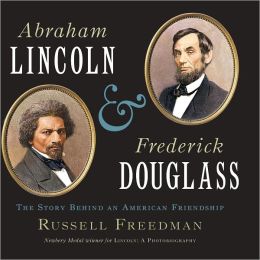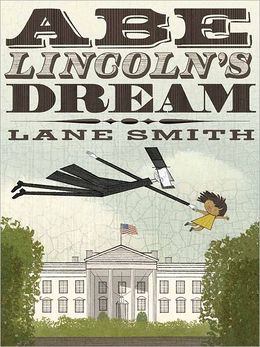I’ve heard that aside from William Shakespeare, more books have been written about Abraham Lincoln than any other historical figure. That makes it difficult to come up with a fresh angle, but Lane Smith has succeeded, and Russell Freedman has at least written a readable history that opens up a few windows for fresh air.
Abraham Lincoln & Frederick Douglass: the Story behind an American Friendship, by Russell Freeman. 

In August of 1863, a somewhat disgruntled Frederick Douglass, the most famous black man and anti-slavery speaker in America, joined the line of solicitors at the White House seeking an audience with the President. His grievances had to do with unequal treatment and pay for Negro soldiers who were currently serving in the Union Army. It had taken an act of Congress, literally, to allow black soldiers to enlist. Now they were serving bravely, but at a wage of $7 a month instead of the $13 accorded to the white enlisted man. Mr. Douglass was prepared to wait all day if he had to, but soon he received word that the President wished to meet him. He ascended the stairs amid the mutters of white men who couldn’t see why the n— was given special treatment.
It’s a good way to start a dual biography, with the first meeting of the two participants. From that point it might have been better to focus primarily on Douglass rather than give equal time to Lincoln, whom Russell has already covered in his prize-winning Lincoln: a Photobiography. If a kid only has time or inclination to read one, however, Lincoln & Douglass is a good pick. After the first chapter, we travel back in time to Douglass’s birth in February 1818 (he eventually discovered the month and year, but the exact date was something his master never saw fit to tell him). Handed off to a series of masters during his growing-up years, he gained snatches of literary knowledge from whites, filling in the spaces until he had essentially taught himself to read. He scraped together pennies to buy one book, The Columbian Orator by Caleb Bingham, whose “Dialogue Between a Master and Slave” (reproduced in the appendix) impressed him deeply. A stint with a “slave-breaker” named Edward Covey drove him to despair: “I was sometimes prompted to take my life, and that of Covey, but was prevented by a combination of hope and fear.”
The hope paid off when he managed to smuggle himself to freedom with the help of friends, after which he settled in New Bedford as a ship’s caulker with a wife and family. That might have been a quiet success story unknown to history, but for his getting involved in the local anti-slavery society and emerging as a powerful speaker. By 1845, his fame far surpassed that of a small-town lawyer named Abraham Lincoln. Who was born in a log cabin in 1809 . . .
The book covers so much ground that events and dates sometimes blur, but Freeman knows how to juggle material and present it in an interesting way. And it’s hard not to feel the jubilance when a meeting of black and white abolitionists in Boston erupt in cheers as news comes over the wire of the signing of the Emancipation Proclamation:
“I never saw such enthusiasm before,” Douglass said. “I never saw joy before. We gave three cheers for Abraham Lincoln and three cheers for almost everybody else.”
His skepticism about the President resurfaced from time to time, but by Lincoln’s second Inauguration, Douglass was entirely won over. Thus might have begun one of the warmest and most productive friendships in history, but for a certain night at the theater. Though I would like to have seen more about Douglass’s Christian faith, this is a solid biography for middle-graders. Older kids should definitely read his own Narrative of the Life of Frederick Douglass, an American Slave, available in an inexpensive edition from Dover Publications, or free at Project Gutenburg.


This book is weird, but if you’re not expecting an informational picture book it can be fun and rather touching. When Quincy is separated from her school group while on a tour of the White House, she comes upon a tall man with a sad face dressed all in black. “’Are you lost?’ she asked. ‘I don’t think so,’ he said, walking through a wall.” She figures out who he is soon enough, and after swapping some corny jokes and sharing their dreams, they become fast friends. Next thing we know, they’re flying over the Washington Monument hand in hand, launched on a tour of this great land. Mr. Lincoln is troubled about the state of the union: Did it stay together? Have we granted equality to the people who once were slaves? Have we done away with bloodshed and war? Quincy has mostly good news for him, though “We’re still working” on that last one.
Printed in an old-timey Playbill font of varying size, with distinctive illustrations, the book will enchant some children and puzzle others—a rudimentary knowledge of the Civil War era is helpful. Not strong on information, though readers will learn some uncanny facts that have long been part of Lincoln lore (did you know that some White House pets refused to go into the Lincoln bedroom, or barked madly every time they came near?). Abe Lincoln’s dream is a promise yet to be fulfilled, but some of the yearning comes through, and a lot of hope.
For more from Russell Freedman, see A Cold Night in Boston. And we haven’t neglected Lane Smith either: see here and here. As for Lincoln, check out Emily’s President’s Day post from last year. And watch for more resources on Washington’s birthday, Feb. 22.
Stay Up to Date!
Get the information you need to make wise choices about books for your children and teens.
Our weekly newsletter includes our latest reviews, related links from around the web, a featured book list, book trivia, and more. We never sell your information. You may unsubscribe at any time.
Support our writers and help keep Redeemed Reader ad-free by joining the Redeemed Reader Fellowship.
Stay Up to Date!
Get the information you need to make wise choices about books for your children and teens.
Our weekly newsletter includes our latest reviews, related links from around the web, a featured book list, book trivia, and more. We never sell your information. You may unsubscribe at any time.
FREE Bible Guide!
Get a guide to the Best Bibles for Children and Teens. Perfect for an Easter gift.
We'd love to hear from you!
Our comments are now limited to our members (both Silver and Golden Key). Members, you just need to log in with your normal log-in credentials!
Not a member yet? You can join the Silver Key ($2.99/month) for a free 2-week trial. Cancel at any time. Find out more about membership here.
1 Comment
Leave a Comment
You must be logged in to post a comment.


Thanks for the reviews, Janie. Seems like so many of the civil war and civil rights books for kids are terribly boring. Glad to know there are some lively ones to watch for in our library!